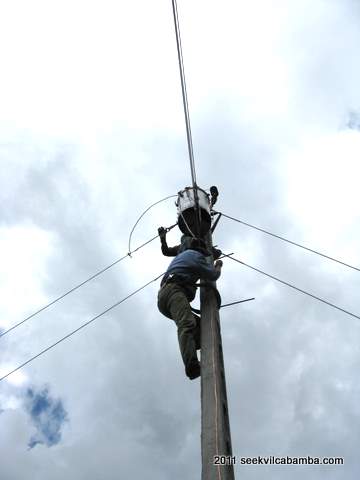Power
In November 2010 the plan for the electrical grid was approved by the
company EERSA. In December 2010, the work commenced.

Yours truly with our first 25KVA transformer waiting to be mounted (the transformer
that is :-))
Taking into account several parameters, we have opted for an aerial system made
out of medium tension lines (13KV), aerial transformers and aerial low tension lines
(110V/220V). These parameters are:
- nature of the terrain: irregular, steep, lots of trees, lots of water gullies, large
distances to cover
- customs, know-how, resources: what is being done here in this country and in this
area
- safety, risks: build a safe system that does not cause troubles in
the future
- cost: build a reasonable and low maintenance infrastructure in line with the rest
of the Rio Uchima project
In New Zealand where I was involved in a similar project before, albeit much smaller,
lines are underground as much as feasible. This is of course better and helps with
the "clean and green" image that this country tries to portrait to the world. This
is also a lot more expensive particularly when it comes to bury lines with 13000
volts of tension on them.
Electricity 101
Why do we use high tension lines you may ask? Anyone who has studied electricity
knows the formula:
Power (Watts) = Voltage * Amperage
The higher the voltage, the less amperage is needed to convey a given amount of
power. The power is what you need to drive your things. For example a toaster will
need 1000 watts. With 110 Volts your toaster will require about 10 Amps going down
the wire, whereas with 13000 Volts, a meager 0.1 Amp will do the same. However I
would not want to be the one picking my toast from a toaster connected to a 13000
Volts power point !
The more Amps an electrical cable needs to convey the thicker and hence more expensive
per meter it needs to be, hence the widespread use of high tension to convey electric
power over large distances.
With our project we are dealing with distances around 1 kilometer, sufficient to justify
the use of high tension. Note that when I use the term "high tension", I really
mean "medium tension". The tensions used to convey electricity on nationwide grids
is what they call "high tension" and is much higher than 13000 Volts.
Of course you don't want to feed your house with a lethal supply of 13000 Volts,
this is why we need transformers, these rather ugly things that they place on top
of poles all over the country.

Why do they place the transformers high in the air and not on the ground? It has
a lot to do with safety. You don't want anyone to have a chance to be near the high
tension as there is mortal danger. You don't want the high tension cables to be
close to the ground either because you then have to seriously insulate them with
expensive plastic shielding to prevent shorts, leaks, fire risks etc... Then you'd
have to inspect the shielding regularly for damage and wear. The easiest, most cost
effective and absolute safest way is "to keep the high tension high" away from the
ground, and only come down to earth after the tension has been reduced to 110V by
the transformer, hence the widespread use of aerial transformers.
We are after all living in a poor country where you'd expect practical and especially
financial considerations to take precedence over aesthetics. My view is that since
we have made the choice to come here we are the ones who have to adjust.
For people who want perfect unspoilt landscapes, I recommend New Zealand. However,
I left NZ for Ecuador and there is a reason for that.
For the technical reasons explained above, the transformers have to be close to
the point of use, your house. As always, there is a cultural aspect to all this.The Ecuadorians don't care if
there is a transformer close to their house. The foreigners do. We know that
transformers emit electro-magnetic radiations and these can cause harm to one's
health when exposed to them over a long period of time. In Loja, the transformers
are in the air and so close to people's bedrooms it can be quite frightening.
Having said that, there are transformers and transformers. They are not all the
same. Here we are talking about small transformers feeding a very small number
of houses. The currents will be minimal and so will be the radiations, and even
more so, if we act on our lifestyles to reduce our energy needs which ultimately
in my view is the right thing to do.We have total control over this. The people
in Loja or Vilcabamba don't.
From the transformer to the houses the power will be conveyed under 110V (or 220V
for those who opt for this extra) which means that the cable has to be of good quality
thick and short. If it is too thin or too long (they recommend 100-200m) the tension
at the house will no longer be 110V but lower, due to heat losses in the cable.
Depending on the appliance, it may be OK or not. A toaster will be very happy with
85V but a fridge will suffer or not work at all.
After these general considerations, let's now take a more detailed look at the property's grid..